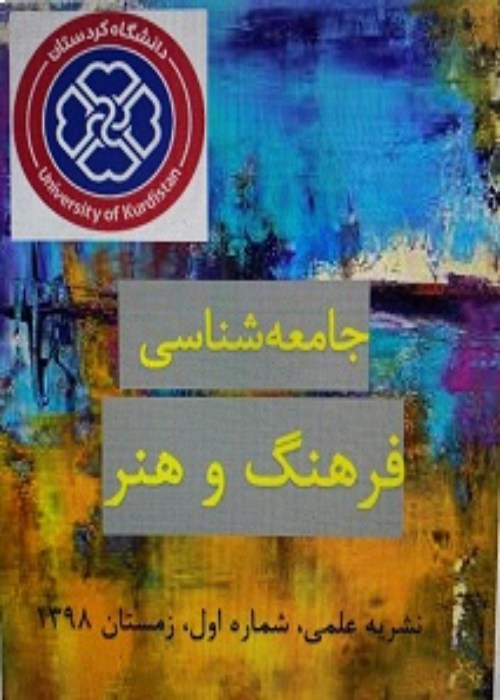From resistance to accepting gender stereotypes among Baloch girls
The aim of this study was to identify the level of resistance or acceptance of gender stereotypes among Baluch female students of Iranshahr University. The theoretical framework of the present study is based on Giddens's theory of identity rethinking. This study is a quantitative and survey research method and a questionnaire was used. The statistical population of this study included all female students of Iranshahr University. The sample size was determined based on Cochran's formula of 277 people and sampling in the present study was based on classification sampling. The results of this study showed that about 3% of respondents were very resistant to gender stereotypes. The results of the correlation showed that there is a significant correlation between the level of religiosity of the respondents, membership in associations and associations, self-satisfaction and the environment with gender stereotypes. Analysis of structural equations showed that the variables of the model, namely the degree of religiosity, membership in associations and societies, self-satisfaction of people and others and the use of new social media, -0.520, 0.096, -0.841 and / 047, respectively. 0 have a significant effect on the degree of resistance to gender stereotypes. Based on the research results, it can be said that considering the context of society as a quasi-modern society and considering the research field which is university level, the level of resistance to gender stereotypes is estimated at a low level and the reason for this is low access to new social media. High level of religiosity, individual satisfaction with living conditions and low level of civic activities such as membership in associations and non-governmental organizations. The aim of this study was to identify the level of resistance or acceptance of gender stereotypes among Baluch female students of Iranshahr University. The theoretical framework of the present study is based on Giddens's theory of identity rethinking. This study is a quantitative and survey research method and a questionnaire was used. The statistical population of this study included all female students of Iranshahr University. The sample size was determined based on Cochran's formula of 277 people and sampling in the present study was based on classification sampling. The results of this study showed that about 3% of respondents were very resistant to gender stereotypes. The results of the correlation showed that there is a significant correlation between the level of religiosity of the respondents, membership in associations and associations, self-satisfaction and the environment with gender stereotypes. Analysis of structural equations showed that the variables of the model, namely the degree of religiosity, membership in associations and societies, self-satisfaction of people and others and the use of new social media, -0.520, 0.096, -0.841 and / 047, respectively. 0 have a significant effect on the degree of resistance to gender stereotypes. Based on the research results, it can be said that considering the context of society as a quasi-modern society and considering the research field which is university level, the level of resistance to gender stereotypes is estimated at a low level and the reason for this is low access to new social media. High level of religiosity, individual satisfaction with living conditions and low level of civic activities such as membership in associations and non-governmental organizations. The aim of this study was to identify the level of resistance or acceptance of gender stereotypes among Baluch female students of Iranshahr University. The theoretical framework of the present study is based on Giddens's theory of identity rethinking. This study is a quantitative and survey research method and a questionnaire was used. The statistical population of this study included all female students of Iranshahr University. The sample size was determined based on Cochran's formula of 277 people and sampling in the present study was based on classification sampling. The results of this study showed that about 3% of respondents were very resistant to gender stereotypes. The results of the correlation showed that there is a significant correlation between the level of religiosity of the respondents, membership in associations and associations, self-satisfaction and the environment with gender stereotypes. Analysis of structural equations showed that the variables of the model, namely the degree of religiosity, membership in associations and societies, self-satisfaction of people and others and the use of new social media, -0.520, 0.096, -0.841 and / 047, respectively. 0 have a significant effect on the degree of resistance to gender stereotypes. Based on the research results, it can be said that considering the context of society as a quasi-modern society and considering the research field which is university level, the level of resistance to gender stereotypes is estimated at a low level and the reason for this is low access to new social media. High level of religiosity, individual satisfaction with living conditions and low level of civic activities such as membership in associations and non-governmental organizations. The aim of this study was to identify the level of resistance or acceptance of gender stereotypes among Baluch female students of Iranshahr University. The theoretical framework of the present study is based on Giddens's theory of identity rethinking. This study is a quantitative and survey research method and a questionnaire was used. The statistical population of this study included all female students of Iranshahr University. The sample size was determined based on Cochran's formula of 277 people and sampling in the present study was based on classification sampling. The results of this study showed that about 3% of respondents were very resistant to gender stereotypes. The results of the correlation showed that there is a significant correlation between the level of religiosity of the respondents, membership in associations and associations, self-satisfaction and the environment with gender stereotypes. Analysis of structural equations showed that the variables of the model, namely the degree of religiosity, membership in associations and societies, self-satisfaction of people and others and the use of new social media, -0.520, 0.096, -0.841 and / 047, respectively. 0 have a significant effect on the degree of resistance to gender stereotypes. Based on the research results, it can be said that considering the context of society as a quasi-modern society and considering the research field which is university level, the level of resistance to gender stereotypes is estimated at a low level and the reason for this is low access to new social media. High level of religiosity, individual satisfaction with living conditions and low level of civic activities such as membership in associations and non-governmental organizations.
- حق عضویت دریافتی صرف حمایت از نشریات عضو و نگهداری، تکمیل و توسعه مگیران میشود.
- پرداخت حق اشتراک و دانلود مقالات اجازه بازنشر آن در سایر رسانههای چاپی و دیجیتال را به کاربر نمیدهد.



